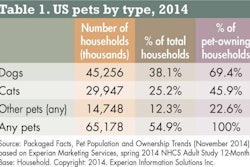Part two of a series: Petfood communication revisited
Joe Zweifel (chairman of the board of directors) and Justin Case (marketing director) of Feed Your Pet Inc. meet again to discuss the ins and outs of Justin’s story for the new petfood brand. The delisting of certain brands has already been talked through and agreed upon.
Joe: You promised me a solid piece of work and that’s what you sent me. I have never known that communication for a brand or a product could be so complicated, that there are so many different elements to take into account. Guide me through the main conclusions and justifications if you want.
Justin: The brand name is not ready yet. And I think that before making a choice, the opinion of the board should be heard. We start to create new intellectual property, which is the brand. It is also important that the board members seek consensus so the new brand becomes their baby as well. Which I feel is essential, because the new brand is the first step in repositioning the company.
Joe: You have a valid point there. If one of your people can make a synopsis of your report, then I can explain to the board what it’s all about. Or maybe even better, you explain it to the board. I keep reading about positioning, but I am not sure whether I fully understand what it is. So, tell me.
Justin: Positioning is—irrespective for product, brand or corporate—the image and attributes that you want to convey to your chosen targets, while answering their question, “What’s in it for me?” The promise, if you like. The positioning must be targeted to a specific group. Claiming to be everything for everybody doesn’t work because it doesn’t really answer the “what’s in it for me” question. Your brand message becomes too diffuse—like the “good for all” I mentioned in an earlier conversation.
The positioning is the core of the brand and defines what we are going to say and how we are going to say this. If our targets would be well-off empty-nesters, you would be ill-advised to communicate in hip-hop language. Or even worse. Imagine the advertisement in a trade journal where the manufacturer of a piece of machinery felt it necessary to have a tiger in front of the machine and a semi-naked yet very beautiful lady on top of it. It beats me why people do this. These two creatures may attract attention but they distract the reader from the message. An unwise investment, as I see it.
And how about end-user advertising in the same trade journals? Your trade partners are not particularly interested in the creation of warm feelings at consumer level; they want to see/hear/read why they should put the products on the retail shelves or in the formulation of their products; the rest is nice to know, but certainly not the core of the message.
Joe: Aren’t you a bit harsh on these manufacturers? I can imagine they want to use what they already have.
Justin: For me, non- targeted communication is a waste of money and time, an investment without a return. A bit of penny wise, pound foolish. Donkey’s years ago I saw this poster on a shop-window: 2 lbs. of salt from US$0.12 to US$0.10. Indeed, a very attractive discount as a percentage. But would people really start to use more salt because it is temporarily cheaper? Or would they build up an inventory for the sake of gaining US$0.02 per 2 lbs.? Or would anybody in his or her right mind change well-established shopping habits for this reason? For me, this was the prime example of a totally useless and insane promotion. And by the way, the retailer went bust, but that was not because of the salt promotion.
Joe: I see that you are deeply rooted in the subject. I never realized that communication could be so complex. I’m just the innocent receiver of a message; and I decide if I do something with it or not.
Justin: That’s exactly the point. Think of AIDA: attention, interest, desire, action. That is what you want to achieve with your communication; and your message must focus on these four key elements. That is what it’s all about. But do not use tigers and semi-nude women as long as you’re not promoting a circus.
And keep in mind that for the same positioning, we have different target audiences. The prescriber wishes to know the science behind the brand and the products, and about the reputation of the company; whereas the retailer wishes to be given reasons to stock and to promote. The end user is mainly interested in what it does for my pet. So, you see that one and the same product and/or brand will have different positionings and messages, depending on who you decide to address.
Joe: I start to get more respect for you marketing people. It’s not all coming out of a magician’s hat after all … But what about the brand message? How can we avoid complications?
Justin: With top of the bill in mind creating for us the opportunity to be special, I have the feeling that we must aim at concerned pet owners: people who want to know about ingredients and their origins. And what they have to do to sustain the health of their pets. Essentially, ingredient selection, health and the human/animal bond are the three pillars. This is what the concerned pet owners take an interest in.
Joe: Super! Do you plan to go on television?
Justin: The choice of tools is yet to be made. Being on television sounds sexy and certainly useful if you want to brag when in the company of your golf friends; but I can’t say now that television is the best after sliced bread for what we aim to achieve. On the whole I can say at this moment, we do not exclude any of the means available to us. It’s just a matter of knowing which combination of means is most beneficial to us and doable from a budget point of view.
Joe: So, I can’t go to the board and say that our new brand will be seen on television? Just imagine the frustration of some of the board members. What else can they brag about when going to their clubs?
Justin: I understand your predicament and what you say makes a lot of sense to me. Remember that you just invited me for doing the presentation to the board. The choice of tools will then be explained and questions will be answered by me. But let’s first get the story right before we start to think about the tools to be used. After all, you’re not going to order brick and mortar before you know what kind of house you wish to build.
21st Pet Street, home of Change Stranamics
















